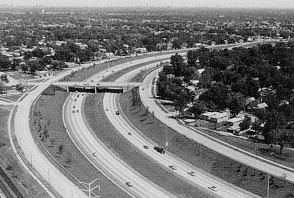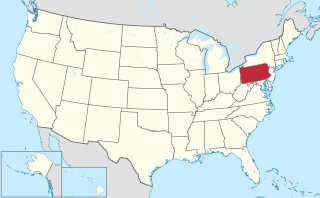
The Chicago Transit Authority (CTA) is the operator of mass transit in Chicago, Illinois and some of its surrounding suburbs, including the trains of the Chicago "L" and CTA bus service.

The Yellow Line, alternatively known as the Skokie Swift, is part of the Chicago Transit Authority's "L" system in Chicago, Illinois. The 5.1-mile (8.2 km) route runs from the Howard Terminal on the north side of Chicago, through the southern part of Evanston and to the Dempster Terminal in Skokie, Illinois, making one intermediate stop at Oakton Street in Skokie.

The Orange Line is a rapid transit line in Chicago, Illinois run by the Chicago Transit Authority as part of the "L" system. It is approx. 12.5 miles (20.1 km) long and runs at grade and serves the Southwest Side, running from the Loop to Midway International Airport. In September 2012, the average weekday boardings on the Orange Line were 63,037.

The Blue Line, also known as the O'Hare-Congress Line and the West-Northwest Line, is a 26.93-mile-long (43.34 km) Chicago "L" line which extends through the Loop from O'Hare International Airport at the far northwest end of the city, through downtown via the Milwaukee-Dearborn Subway and across the West Side to its southwest end at Forest Park, with a total of 33 stations It is the CTA's second busiest rail line, with an average of 186,796 passengers boarding each weekday in September 2012.

The Brown Line of the Chicago "L" system, is an 11.4-mile (18.3 km) route with 27 stations between Chicago's Albany Park neighborhood and downtown Chicago. It runs completely above ground and is almost entirely grade-separated. It is the third-busiest 'L' route, with an average of 63,481 passengers boarding each weekday in 2017.

The Green Line is a rapid transit line on the Chicago Transit Authority's "L" system. It is the only completely elevated route in the entire system. It utilizes the system's oldest segments, extending 20.695 miles (33.305 km) with 30 stops between Forest Park and Oak Park (Harlem/Lake), through Chicago's West Side to the Loop, and then to the South Side and West Englewood (Ashland/63rd) and Woodlawn. As of September 2012, the average number of weekday boardings on the Green Line was 70,554.

The Purple Line of the Chicago Transit Authority is a 3.9-mile (6.3 km) route on the northernmost section of the Chicago "L" rapid transit system. Normally, it extends south from Linden Avenue in Wilmette, passing through Evanston to Howard Street, on Chicago's north side. In 2016, the average weekday boardings on the Purple Line was 10,187.

The Pink Line is an 11.2 mi (18.0 km) rapid transit line in Chicago, run by the Chicago Transit Authority (CTA) as part of the Chicago "L" system. It is CTA's newest rail line and began operation for a 180-day trial period on June 25, 2006, running between 54th/Cermak station in Cicero, Illinois and the Loop in downtown Chicago. The route to the Loop follows tracks shared with Green Line trains on Lake Street, connected by the previously non-revenue Paulina Connector. In September 2012, the average weekday boardings on the Pink Line was 33,737. The Pink Line does not make any 'L' train transfers on the Douglas Branch. The Pink Line operates between 54th/Cermak and the Loop, weekdays from 4:05 a.m. to 1:25 a.m., and Saturdays and Sundays from 5:05 a.m. to 1:25 a.m.

Dempster–Skokie, formerly known as Dempster, or Skokie, is a station on the Chicago Transit Authority's 'L' system, on the Yellow Line at 5005 W. Dempster Street in Skokie, Illinois. It is one of three stops on the Yellow Line, and currently the terminus of line, although an extension of the line to Old Orchard Mall has been considered. It is one of two CTA rail stations in Skokie, and is at grade level. It is also one of two terminals that doesn't have a rail yard assigned to it. All 6 cars assigned to the Yellow Line are stored at the Howard Yard. The Skokie Shops are accessible only via the Yellow Line's tracks, but the shops do not function as a yard, only as a shop for rail cars. This station is one of two CTA rail terminals that does not have an island platform, the other being Cottage Grove on the Green Line. Passengers who wanted to return to Howard from this station after leaving a train arriving at this station had to always pay an additional fare.
The current rolling stock of the Chicago "L" rapid transit system consists of three series of railcars. The oldest series is the 2600 series which was built between 1981 and 1987 and refurbished between 1999 and 2002. The second series is the 3200 series, built between 1992 and 1994 and refurbished between 2015 and 2018. The third and newest series is known as the 5000 series; built between 2009 and 2015, they feature new technologies such as LED color signs, security cameras, new seating configuration, AC motors, and date and time.

The 2400 series is a series of Chicago "L" cars built between 1976 and 1978 by Boeing-Vertol of Ridley Park, Pennsylvania, with shells fabricated by Sorefame. 200 cars were built and on October 31, 2014, the series was retired from revenue service. These cars were in service for 38 years.

The 5000 series is a series of Chicago "L" car built by Bombardier Transportation of Plattsburgh, New York. A $577 million order for 406 cars was placed in 2006. In July 2011, the CTA ordered 300 more cars for $331 million as an option on the first contract.

The 2000 series was a series of Chicago "L" car built in 1964 by Pullman-Standard of Chicago, Illinois. 180 cars were built.

The 2600 series is a series of Chicago "L" car built between 1981 and 1987 by the Budd Company of Philadelphia, Pennsylvania. 600 cars were built, and 503 of them remain in service as of 2019.
The Lake–Dan Ryan Line was a rail rapid transit route formerly operated by the Chicago Transit Authority (CTA). The Lake–Dan Ryan Line existed from the opening of the Dan Ryan branch on September 28, 1969 until February 21, 1993. When created, the route united two transit corridors that until 1969 never had through rail service. This routing, which became known as the West-South Route, operated from the Harlem terminal in Forest Park on the Lake Street "L" through downtown Chicago along the Union Loop "L", and then via the old South Side "L" and the new Dan Ryan Line to the 95th Street Terminal. The Lake-Dan Ryan service was planned in conjunction with the former Franklin Street Connector and Chicago Central Area Transit Project, both of which were never constructed. The section of the route between the junction with the South Side "L" at 17th and State Streets and the Cermak-Chinatown Station was originally an "interim" or temporary facility, which was to be torn down when the Loop Subway system was completed, but survived after the project was cancelled in 1979. That section was improved in the 1980s and early 1990s and is currently used by the Orange Line. Train transfers are possible by using the two unused tracks.

The 7000 series is an upcoming series of rail car for the Chicago "L". The base order is for 400 cars and will be used to replace the 2600-series cars, dating back to the 1980s, which are currently assigned to the Blue, Brown, and Orange Lines. If the Chicago Transit Authority (CTA) orders the additional 446 cars, these cars would replace the 3200-series cars, dating back to the early 1990s, which are currently assigned to the Blue and Brown Lines. Including all options, which is a total of 846 cars, the order will cost $1.3 billion. The contract requires ten prototypes to be delivered by October 2019. If the rail cars prove to be acceptable, then full production cars would be delivered starting in October 2020, at a rate of 10 cars per month. The cost per car is approximately $1.58 million.























